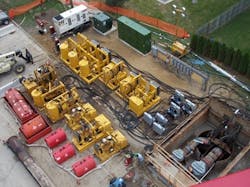Normal dry weather flow through the interceptor is 50 cubic ft per second. During a storm it rises up to approximately 100 cubic ft per second, or 45,000 gallons per minute.
This was an emergency situation that required the mobilization of many contractors, according to Inland Waters Pollution Control, Inc., the prime contractor on the project.
Immediate action was required to stabilize the situation and to bypass the sewage from this major interceptor while repairs were made. MWI Rental working through Thompson Pump Midwest was brought in for the unique capabilities of the MWI Hydraflo pumps. Following the testing of types of pumps, it was determined that they were just not capable of meeting the flows and heads needed to keep the system fully functional.
Successful option
According to Inland Waters Pollution Control, the Hydraflo is a portable, axial or mixed flow pump, which is hydraulically driven. The pumps are capable of very high flows and moderate heads and are connected to the drive units by high pressure, flexible hoses. The design also allows the pump units to be bolted together in series increasing the head by a factor of two or three. These features provide great flexibility in setting up the pumps with their drive units, allowing them to be quickly and easily installed.For the installation in Macomb County, Mich., the initial effort was to mobilize on the project and begin pumping quickly. MWI quickly installed multiple pumps in two holes they had drilled, each one 75 ft deep. Both the set up and sustainment phases required operating 24 hours a day seven days a week.
Triple staged
The pumps were triple staged—that is three pumps, each run by its own drive unit were bolted together in series.In each hole was a 24- and 30-in. stack of triple staged pumps along with discharge pipe. Each of these stacks pumped 20,000 gallons per minute of raw sewage. The pumps had to accommodate the wide range of material that flows through large sewer lines, from sections of lumber to disposable diapers. The outflows were through a manifold into a 36 in. pipe, which ran for a mile to bypass the damaged section.
Each drive unit used an electric motor as the primary power source with a diesel engine as a back up. The 24-in. Hydraflos were driven by 175 hp engines/motors and the 30-in. pumps had 275 hp engines/motors.
In addition, three pumps of each size were on site for backup if needed. These pumps ran non stop for several months until a more permanent bypass could be installed. However, the permanent bypass would not have been possible unless this temporary solution, implemented quickly, was successful.
Sewage bypass operations are becoming more and more frequent, usually during a planned replacement or repair to a sewage system. Occasionally, pumps are needed in emergency situations like the Macomb County application and selecting the right pump or sets of pumps can be a challenge in either case.


